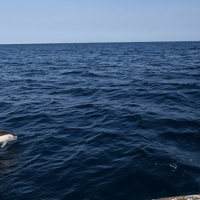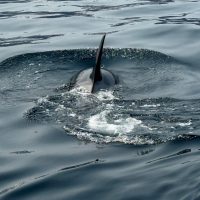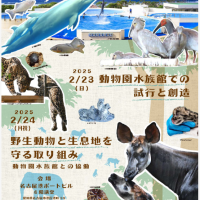Mitani Y, Bando T, Takai N, Sakamoto W
Fish Sci 72 (1): 69-76 (2006)
要旨:北西太平洋におけるミンククジラの摂餌履歴を推定するため,ヒゲ板成長層毎に炭素(d13C)・窒素(d15N)安定同位体比分析を行い,餌生物の値と比較した.ヒゲ板中d15Nには1-2カ所の谷状部が見られ,これらは初夏におけるオキアミから魚への餌変化によるものと示唆された.ヒゲ板成長速度は129mm/年と計算され,ヒゲ板には1.4年の摂餌履歴が記録されていると考えられた.一部の未成熟個体のヒゲ板先端部においてd15Nが高くなっていたことから,d15N分析は離乳直後の個体と,それ以降の未成熟個体を分ける有用な方法であると考えられる.
ABSTRACT: Stable carbon and nitrogen isotope ratios were determined in the baleen plates of 17 common minke whales (Balaenoptera acutorostrata) from the northwestern Pacific Ocean off Japan as well as prey species (krill [Euphasusia pacifica], Japanese anchovy [Engraulis japonicus] and Pacific saury [Cololabis saira]) collected in the stomach contents to investigate the trophic relationship between the minke whales and their prey. A few d15N-depleted peaks occurred along the length of baleen plates for 10 males irrespective of stomach contents (anchovies and sauries). Similar d15N-depleted peaks were also found for one female and two immatures. It was likely that these d15N-depleted peaks formed in early summer. The d15N values in Pacific saury (9.3±1.4‰) did not differ significantly from that in Japanese anchovy (8.8±0.9‰). In contrast, d15N in krill (7.2±0.5‰ in July and 8.0±0.2‰ in September) was significantly lower than in Pacific saury. Thus, we expect that these peaks might reflect the dietary change from krill to fishes in the feeding migration of the whales. Growth rate of the baleen plate was estimated to be 129 mm y-1, and it appeared that dietary record of about 1.4 years remained in the baleen plate. For two immature whales, the maximum value of d15N occurred at the tip of baleen. This d15N enrichment may possibly be useful for discriminating weanlings and older whales.
Key Words: common minke whales, stable isotopes, baleen, feeding ecology, North Pacific





